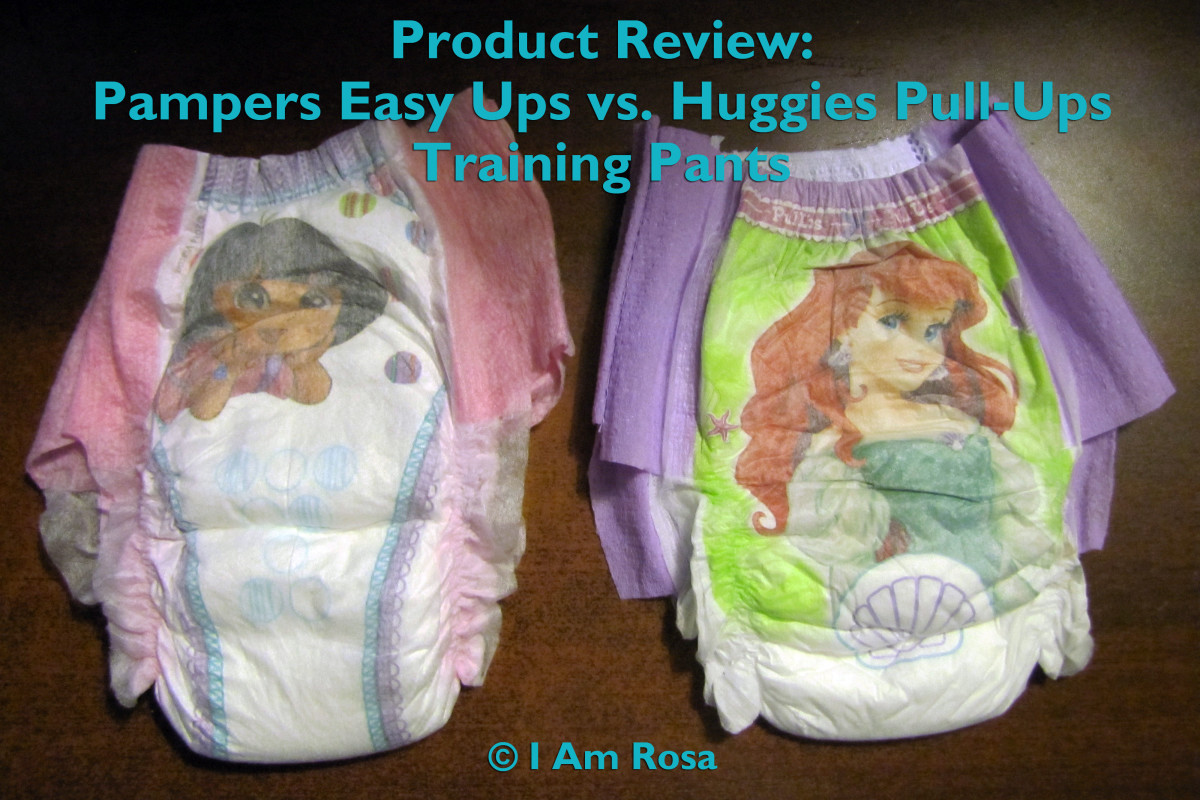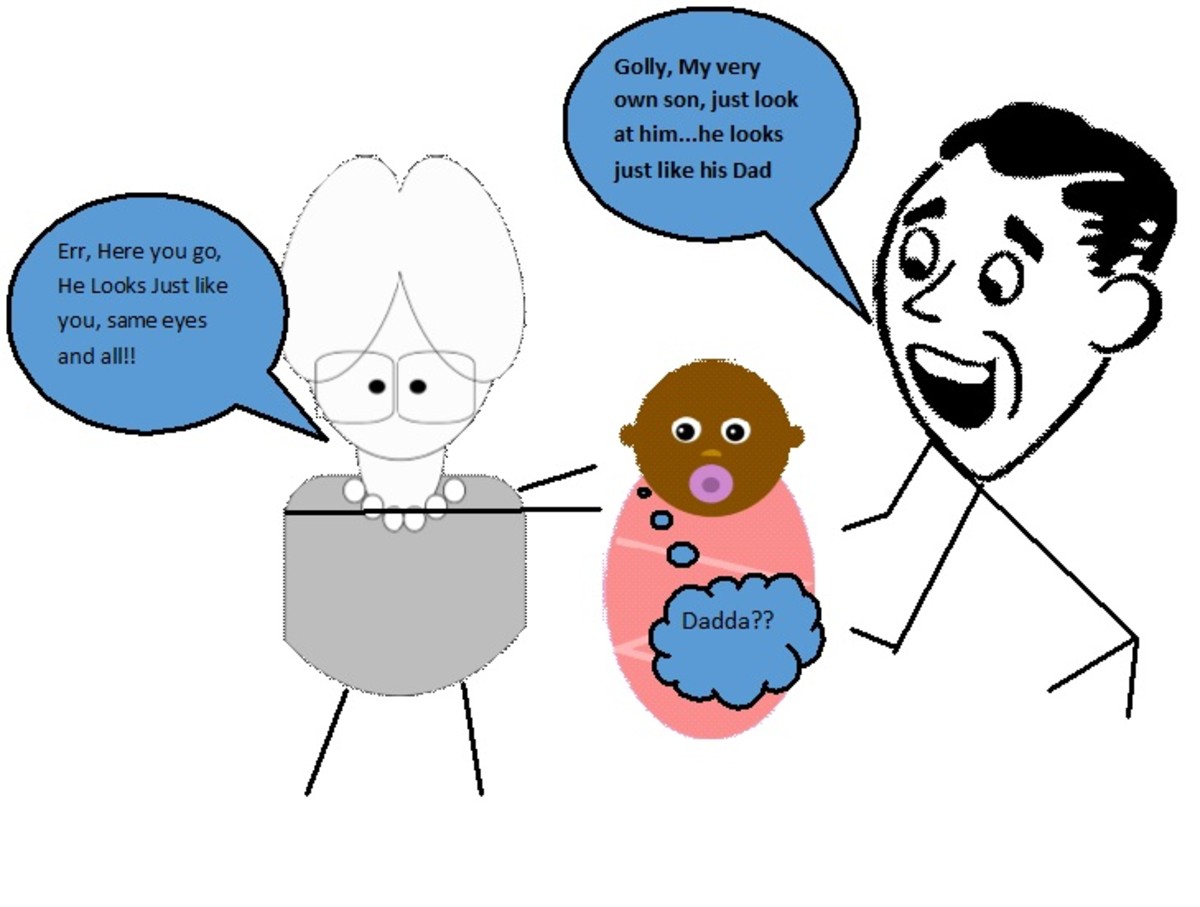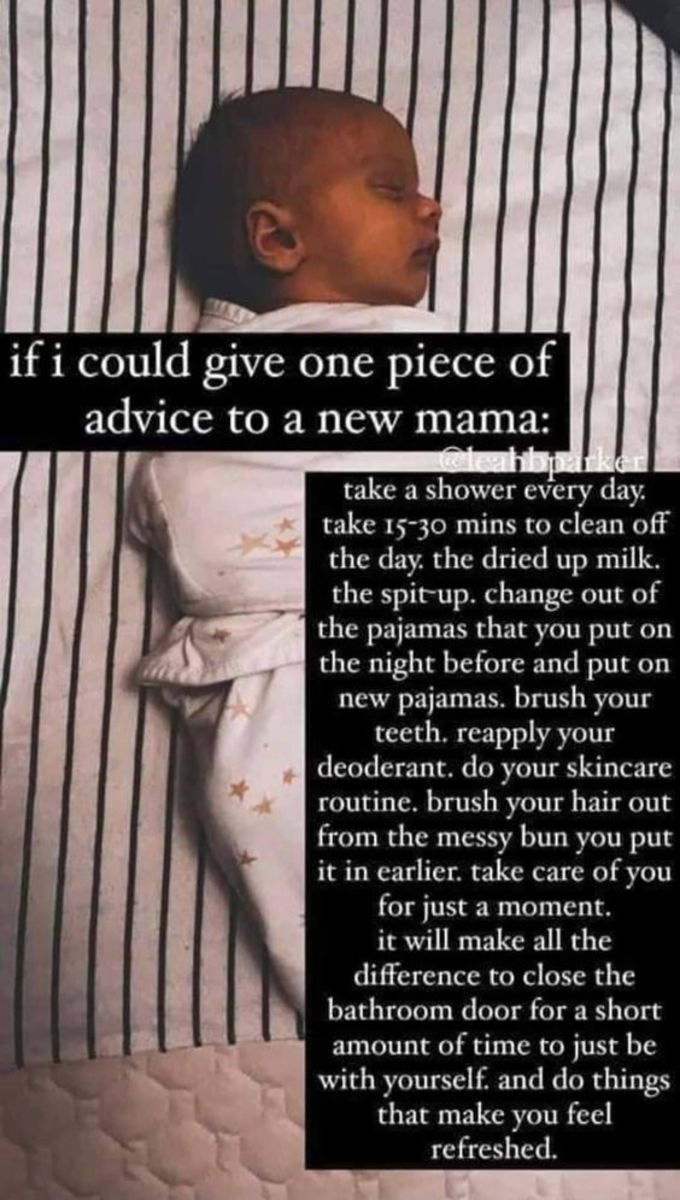Cloth Baby Diapers
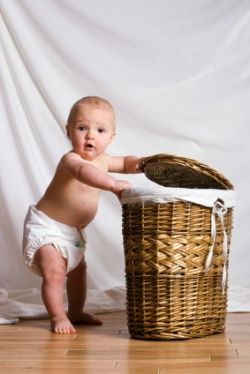
Cloth diapers are what all the cool babies wear!
Do you know what is in the diapers you put on your baby? Unfortunately most people don't know what is in the diapers they purchase for their small children. Since they are widely accepted as the diapering standard, they use them without ever considering that there are alternatives. After all, cloth diapers are such a pain to take care of, and kids just wet through them, right?
Actually cloth diapers have come a long way baby! There are several options available for cloth diapering and there are several reasons to use them as well. Take a look at the following:
Cloth diapers are better for baby's skin. Disposable diapers are loaded with chemicals that can irritate baby's tender skin, Cloth diapers often sport natural fibers like cotton that are soothing to the skin and very breathable. They get fewer diaper rashes, which means less discomfort for baby and less crying.
Disposable diapers are also filled with toxic allergens. Your baby might even be allergic to disposable diapers. There are many things in them that can cause allergic reactions, such as problems breathing and rashes. If your child is having these problems you should consider cloth diapers.
Cloth diapers are better for the environment and your pocketbook. Cloth diapers are reusable from child to child, which means less waste going into our already overstuffed landfills. You should figure that in the years one child is diapered you will go through on average, 2500 to 3000 diapers. With cloth diapers you could easily get by with using only 3-4 dozen diapers and those diapers can be used on one or more subsequent children.
When you are done with your cloth diapers you can sell them too at usually 50-75% of the retail price of new ones. That means you can get back 3/4 the cost of using cloth diapers. Even after you factor in water, time and detergent you are still winning out compared to the $20 a week you spend on diapers.
Washing diapers is very easy too. It should not amount to more than a load or two of extra laundry each week. Wet diapers can be tossed into a diaper pail to wait for cleaning and diapers with loose stools can be shaken out over the toilet before they too are stored before washing. Odor issues can be controlled by placing a tissue with a few drops of essential oil at the bottom of the diaper pail or sprinkling the pail with baking soda.
Cloth diapers have also greatly evolved in terms of style and ease of use. There are many options available for cloth diapers including some all-in-one (AIO) varieties that closely resemble disposable diapers as far as ease of use goes. There are pocket diapers for parents who want to customize absorbency and there are one-size diapers for parents who want a diaper that will grow with their children. There are also diapers available to use for night time, and diapers to use while potty training.
You can also make your own cloth diapers with several patterns available online. That reduces the cost even more. It really is easier to use cloth diapers than you might think. Before you check them off as an option, give them a shot, you might really like the benefits and how happy your baby is in them.
Photo Source: Deposit Photos
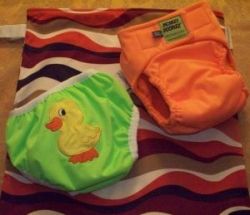
An Introduction to Cloth Diapers
There are many decisions that new moms and dads must make when they first find out they are having a baby... from picking the right car seat to picking the right name. Add to that list of decisions the choice you will have to make between disposable and cloth diapers. While disposable diapers have been the most mainstream diapering option in the last few decades, cloth diapers have evolved greatly and have become a more convenient and accessible option. Here are just a few of the reasons you may want to give cloth diapers a try:
* Cloth diapers are fitted and snug.
In days past, the most common diaper type was a flat piece of cloth that had to be folded to fit a baby's form and then fastened with safety pins. Today there are cloth diapers that resemble disposable diapers with their contoured shape, elastic in the legs and back, and easy closures like Velcro or snaps. Some diapers have a one-size option, so that one diaper can last from birth to potty learning.
* Cloth diapers are infinitely more attractive than disposable diapers.
When disposable diapers are your only option then it is easy to put function before fashion but with cloth diapers you can have it all. Cloth diapers come with a variety of different fabric options... velour, bamboo, organic cotton, silk, and fleece, among others. The fabric patterns and colors are also endless. From electric pink to midnight blue and from tie dye to Tinkerbell, parents who use cloth diapers never get bored with all their choices.
* Cloth diapers are cost effective.
The baby business is booming and you can easily spend a fortune on diapers, baby clothing, accessories, toys, and furniture. If you need to be cost conscious then cloth diapers will help you save money. It is almost always more frugal to reuse items than to buy new every time and cloth diapers are no exception. Experts estimate that disposable diapers can easily cost up to $3000 over a three year period. Cloth diaper costs usually range $300 to $800 from birth to age three. If you are inclined to sew your own diapers and use reclaimed materials you can use cloth diapers for next to no money at all.
* Cloth diapers are the more environmentally friendly choice.
As cloth diapers climb in popularity there has been an increase in corporate funded studies designed to show that cloth diapers have just as much environmental impact as their disposable counterparts. The claim is that energy and water usage from laundering cloth diapers is comparative to the environmental impact of disposable diapers in our landfills. These studies conveniently forget to factor in the energy and water usage created from mass manufacturing disposable diapers in a factory, the lost of precious resources as trees are cut to make the paper pulp innards of these diapers, and the tremendous impact of shipping disposable diapers all over the world by ship, plane, and truck. When ALL the environmental factors are considered, cloth diapers seem to be the clear cut winner in the great diaper debate.
It is not hard to see why more and more parents are factoring cloth into their diapering decisions.
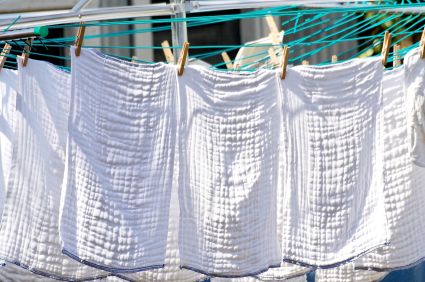
How To Cloth Diaper Without Breaking the Budget
Cloth diapers are often touted to be the frugal option, and this can certainly be the truth. However, if you've seen some of the fancier cloth diapers that cost $15 to $30 a pop you may have your doubts! While some of these diapers are certainly wonderful products, don't be misled. It's very possible to cloth diaper successfully as well as inexpensively. Here are a few tips from moms who wanted to save as much as possible while keeping their babies comfy and dry.
Pick your system
One of the reasons cloth diapering may be expensive initially is because of the investment of the first stash of diapers. Babies who are in cloth will be changed more frequently. It's not uncommon for a young baby to go through ten cloth diapers a day, maybe more for a newborn. Unless a mom wants to wash daily, she'll need a couple dozen diapers. One way to save money from the get go is to know exactly what kind of cloth diaper "system" you want to go with so you don't become unhappy with the diapers you've chosen and end up selling them at a loss.
Ask other cloth diapering moms what they like and why. Some of the questions to ask are: "What types of diapers fit babies with my baby's body shape best?" "What diapers are best for babies who have other caretakers?" "What's best for newborns/older babies/heavy wetters/toddlers?" etc.
The cheapest and often simplest cloth diaper system is that of prefolds with waterproof diaper covers. Prefolds are inexpensive and will last for multiple children. They are also quite thirsty and require no special care. Waterproof diaper covers are usually around $10 a pair and only a few are needed in each size. They will also last a long time if washed gently and air dried. All in ones tend to be the costliest diaper system, but are super convenient for babies in day care and for travel. Daddies and Grandmas tend to prefer them too for their ease of use.
Some cloth diaper websites also allow you to try before you buy. For just a few dollars they will send you a diaper and allow you to use and feel it, then return it.
Budget conscious moms should also ask for friends and loved ones to give them cloth diapers as baby shower gifts. Many of the cloth diaper websites offer gift registries. Big box store bought cloth diapers and covers are generally low quality so steer clear of those.
Buy used cloth diapers
Cloth diapers can be obtained at thrift stores, online auctions, diaper swap forums, consignment sales and shops, and more. Just do a Google search to find lots of options.
Some larger cities have diaper services that sell cloth diaper seconds. If their prefolds have a spot on them that can't be removed, they take them out of circulation. The diaper service sells these perfectly serviceable, high quality prefold diapers for pennies. It's worth a phone call.
Care for your diapers
Don't bleach your diapers as this will wear them out fast. Borax also tends to wear diapers prematurely. Even vinegar harms some diapers. It's best to use a natural detergent and to use as little of it as possible to get the job done. Rely on presoaking in your machine to help with stains instead of using stain removers. Enzyme cleaners can eat away at your diapers too. Many additives are not appropriate for diaper covers. Hang your diapers in the sun to whiten them, and don't overdry them if you do use a dryer. Baking them for too long in the dryer breaks down the elastic and cotton.
Cloth diapering is certainly the healthier option, the better option for our planet, and more comfy for babies. With some creativity cloth diapering can also be the frugal choice.
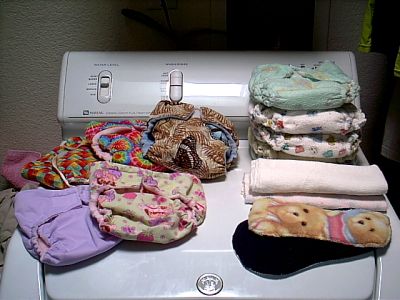
Washing Cloth Diapers
Most parents know the advantages of using cloth diapers rather than disposable diapers. Cloth diapers can save a ton of money, and they are gentler on the environment. However, even knowing all this, parents continue to shell out big bucks for disposable diapers, figuring they just can't handle the inconvenience of laundering cloth diapers.
I believe the biggest deterrent to cloth diapering is the laundering. You would think cloth diapering mamas individually hand-washed every single poopy diaper. The truth is, cleaning those cloth tush covers is as easy as handling any other kind of laundry. You throw a load in the washing machine, turn it on, and let it go. The machine does the work. Then you transfer that load to the drier and let it finish the job. Finally, you put the diapers away and reuse them.
There are a few simple changes to make sure the diapers are thoroughly clean, so laundering cloths takes a little longer. First, collect the soiled and wet diapers in an enclosed container. A kitchen trash receptacle with a lid works well. You can line the receptacle with either a plastic trash can liner, or you can purchase a reusable bag from a cloth diapering supplier. The reusable bag can be washed along with the diapers and line dried.
Once the bag is full, dump the contents into the washing machine and set it to wash a cold cycle. You can add soap if you want, but the main purpose of the cold wash is to help prevent the soiled diapers from staining. I have found plain water works really well. When the cold wash cycle finishes, set the washing machine to wash with hot water. Then add a normal amount of your favorite detergent, plus 1/4 to 1/2 cup of borax, and let the cycle run. At the end of the hot wash cycle, you can re-rinse if you like. Otherwise, take the diapers out and toss them into the drier. Depending on what kind of diapers you are using, set the drier to run either a regular or cool drying cycle, and turn it on. You can also line dry the diapers, but that really would be more work. Reuse the diapers again and again.
Here are a few things to keep in mind to make washing cloth diapers as easy as possible and to extend the life of your diapers.
1. When the diaper is soiled, you don't have to do anything extra for babies who are still exclusively breastfed. The washing machine will take care of it. When the baby is eating solid foods the poop will be more solid and will need to be scraped off. Gently scrape off the big chunks with a bit of cardboard. You should try to get as much off the diaper as you can, but the washing machine can still handle a surprising amount of residue, so don't overdo it. Just get rid of the really solid stuff.
2. Do not use bleach or fabric softeners. Bleach will break down the fibers in the diapers, shortening their useful life. Fabric softeners tend to add residue to the diapers which can irritate baby's bottom as well as cause the diapers to repel, rather than absorb water. Rely on the hot water, soap and borax to sanitize the diapers. If they smell clean, they are clean.
Washing cloth diapers may seem more complicated at first, but it's really more work for your washing machine, and maybe a bit more patience for you. Once you've washed a few loads, it becomes second nature and you too will be scratching your head when your friends balk at using cloth diapers on account of the laundering.
The BumGenius Cloth Diaper
BumGenius 2.0 OneSize cloth diapers are the most versatile and easy cloth diapers that I have ever used. They are a pocket diaper and come with a Cotton Babies microfiber insert that snaps down for easier fit when the diaper is sized for a small infant, or to absorb more in certain areas. The outer fabrice is so soft to the touch and deliciously stretchy. The diaper snaps to make 3 different sizes out of the same diaper, fitting from 8lbs to 35lbs. BumGenius is so easy to clean, too. I love that any hard bowel movement just falls right off, and anything that doesn't fall off washes right out, no need for dunking and swishing in the toilette.
I love being able to throw one kind of diaper in the diaper bag and I know that with a couple of snaps it is going to fit my new baby or my toddler. I also love the stretchy tabs and the crossover velcro that allows you to fold up the diaper and secure it shut until you get home to wash it.
The suedecloth and fleece inners are both wonderful fabrics and are easy to clean. BumGenius have never leaked for me in the 10 months I've been using them.
Thirsties Fab Fitted Diapers
A fitted cloth diaper, made with absorbant inner, velour outer and microfleece inside next to baby skin.
Thirsties are very absorbant, super soft and very easy to use. My son is a super soaker, when the new Thirsties Fab Fitted's came out I bought a few, then a week later I sold all of my other diapers and bought 12 more. We have never had a leak with these diapers. The whole diaper is so soft, both the outside and the insides have stayed just as soft over multiple washings as they were they day we bought them. The aplix closures make they really user friendly, even my 9 year old likes to change his diaper now! They also come in some really cute and fun colors. They also have matching covers that make our cloth diaper stash really pretty.
The only thing I do not like about these diapers is that the aplix laundry tabs don't work very well. They come apart in the wash and stick to each other, but it hasn't caused any problems for us.
Snappis To Fasten Prefold Cloth Diapers
What would I do without my Snappis? Probably jump at any excuse to use disposable diapers--anything to avoid those diaper pins!
Snappis are stretchable rubber fasteners. They have teeth on all three ends that grip the diaper. You pull each end of the snappi, get the teeth to dig into the diaper, and when all three ends are in place baby's diaper is securely fastened. What do you like about the product? The biggest advantage about Snappis is that they will forever free you from the perils of diaper pins. I used diaper pins for my first baby, before I knew of the existence of snappis. And oh, the fear that plagued me with every diaper change, the suspense, the worry, the ever-present question: will I poke my sweet baby with the pin? Or even worse, will the pin come undone in the diaper and stick her in a tender spot? Fortunately that never happened, but my husband and I poked ourselves numerous times with the pins. We also used way more disposables than I'd like to admit on this site :-)
Then we found Snappis, and diaper changing has never been easier. Gone is the concern that I might poke my baby. If the Snappi should come undone, it might tear the rubber pants, but never the baby. People who have seen me change my baby have oohed and aahed over the snappis and expressed that they wished they had those when their now grown children were babies. For some, it would have gotten them using cloth diapers, saving our landfills from 3,000 disposables per child. For others, it would have saved them needless suffering and anguish over diaper pins.
Snappis are inexpensive, costing barely more than a set of diaper pins. Even if your last baby is just about potty trained and you've been using pins all this time, it would be well worth it to replace those pins with a set of Snappis.
Nothing lasts forever and Snappis do break after a while. The part with the teeth sometimes pokes holes in the soft rubber that's holding it in place. You can still use the Snappis but sometimes you have to adjust them.




